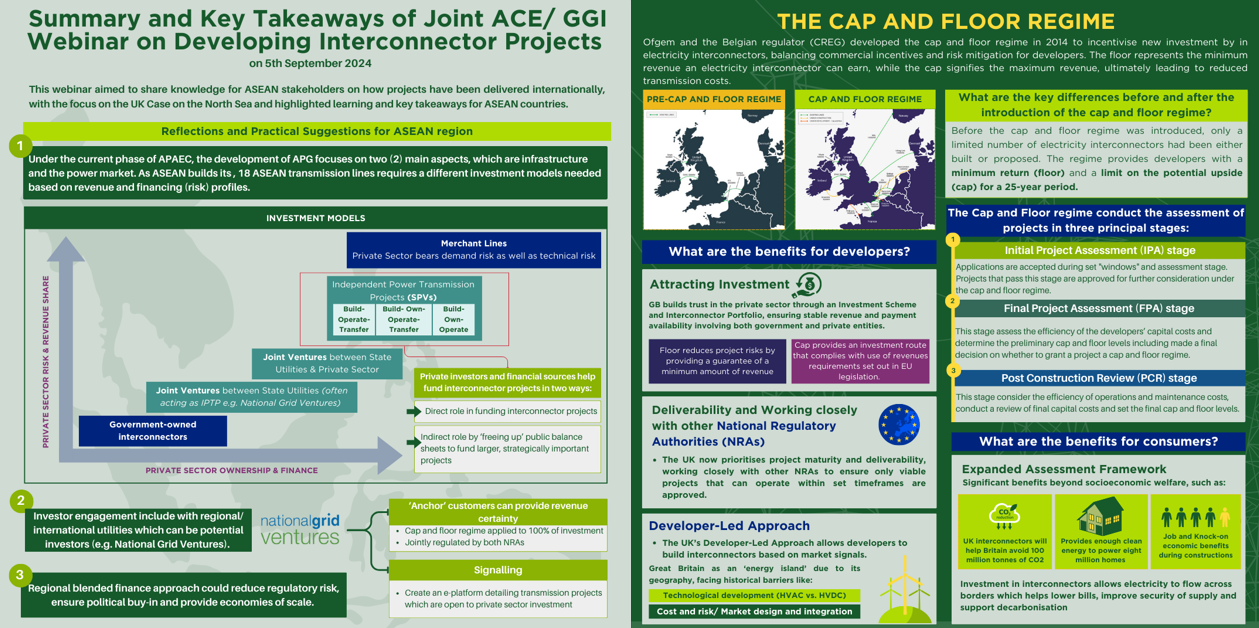Menu

Photo 1. Group Photo of Developing Interconnector Projects Webinar panel speakers and ACE representatives
The ASEAN Centre for Energy (ACE) and the Green Grid Initiative (GGI) jointly hosted a webinar titled Developing Interconnector Projects. The virtual seminar drew 156 participants, includes diverse range of organisations, government agencies, educational institutions, and private companies within ASEAN region and beyond. The joint webinar gathered panellists from the UK Government’s Department for Energy Security and Net Zero and the Japan Bank for International Cooperation (JBIC) aimed to explore opportunities for advancing interconnection projects while also address the energy security, accessibility, affordability, and sustainability across ASEAN, with a focus on learning from the North Sea interconnectors and discussing future grid interconnected pathways that are aligned with the ASEAN Plan of Action for Energy Cooperation (APAEC) Phase 2: 2021 – 2025, Program Area No. 1: ASEAN Power Grid (APG).
The webinar began with the opening remarks from Beni Suryadi, Acting Executive Director of ACE, extend his honour to the Green Grid Initiatives for the seminar collaboration in serving a catalyst for a deeper regional level’s discussion. He perceived the importance of learning from cross-border interconnectors projects and the need for innovative financing models and stronger political to implement the multilateral energy cooperation and advance regional integration to fulfil the delivery of the AIMS III under the APAEC Phase II.
The session started with a presentation by Nadhilah Shani, Senior Research Analyst on Power at ACE, delivered on the ASEAN Power Grid Introduction. She discussed the current status and future roadmap of the APG, highlighted the importance of accelerating the infrastructure development under APG to facilitate greater shared utilisation of RE across the region. The big challenge to tackle on this effort is how to finance new additional capacity for transmission network. Innovative business model and policy regime in place is necessary to address this financing puzzle.
The panel discussions featured a distinguished expert which offered North Case study, contained a developer, regulators, investor perspective for the regional interconnector projects. The session begins with presentation by Marcus Stewart, Head of Secretariat at the Green Grid Initiative, started the session on the Principles for Interconnectors. He provided an overview of the critical stages of interconnector development, such as feasibility studies, regulatory approvals, and financial planning. He emphasized the benefits of cross-border connectivity, which allows system operators to take advantage of larger, more diverse power systems, ultimately leading to greater energy security and operational flexibility for ASEAN countries.
Followed the session, Mark Tunney, Head of Business Development at National Grid Interconnectors, introduced the North Sea Case Study by shared lessons from developing 4.8 GW of interconnection capacity across several key projects such as Viking Link, Nemo, IFA2, and NSL. He conveyed the importance of early stakeholder engagement, technical readiness, and managing regulatory frameworks to ensure project success.
Moved on to the next presentation by Okon Enyenihi, Head of Interconnector Delivery at Ofgem, who provided a Regulator’s Perspective, focusing on the Cap and Floor regime. This regulatory model has been essential in learning from investments for UK interconnectors by offering developers a secure minimum return (the floor) while capping potential profits. He discussed how this model could be adapted to support interconnector development in ASEAN, ensuring stable returns for investors as well as protecting consumers.
The next panellists, Takuya Okuma, Director for New Energy and Power Finance at JBIC, shared his experiences in funding interconnection projects in the North Sea, focusing on the role of financial institutions in de-risking large-scale infrastructure projects. He highlighted innovative financing mechanisms, including public-private partnerships and project financing, as critical tools for advancing ASEAN’s interconnection initiatives.
In the end of the session, Ivana Dimitrova, Southeast Asia Regional Lead for Green Energy and Industrial Decarbonisation at the UK Foreign, Commonwealth & Development Office (FCDO), discussed the UK Government’s Support Offers. She outlined the UK’s ongoing efforts to support ASEAN’s energy transition through capacity-building programs and financial assistance, particularly for decarbonisation and industrial energy projects.

Photo 2. Key take aways on the Importance of Financing Interconnectors in the moderated Q&A Session
During the Q&A session, moderated by Nadhilah Shani, the panellists addressed a range of audience questions, offering deeper insights into the challenges and opportunities of developing interconnector projects in ASEAN. Marcus Stewart highlighted the importance of political stability and regulatory frameworks in ensuring the success of interconnector projects while Okon Enyenihi further elaborated on how the Cap and Floor model reduces risks for developers, then Mark Tunney and Takuya Okuma continued to discuss the importance of early financing and stakeholder alignment. Ivana Dimitrova added that international collaboration is crucial for overcoming technical and financial barriers in the sustainable and economically viable.
The webinar concluded with closing remarks from Putri Aprilia Maharani, Junior Associate Research Analyst at ACE, deliberated her key takeaways from the day’s discussions with the need for continued collaboration between ASEAN and Green Grid Initiatives to strengthen energy cooperation across ASEAN toward a more integrated and sustainable energy future.
